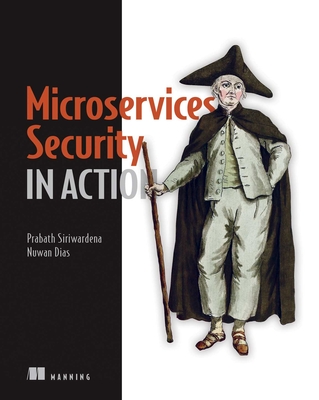Cyber Security Engineering: A Practical Approach for Systems and Software Assurance (SEI Series in Software Engineering)
Nancy R. Mead, Carol Woody
- 出版商: Addison Wesley
- 出版日期: 2016-11-10
- 售價: $1,660
- 貴賓價: 9.5 折 $1,577
- 語言: 英文
- 頁數: 384
- 裝訂: Paperback
- ISBN: 0134189809
- ISBN-13: 9780134189802
-
相關分類:
資訊安全、軟體工程
已絕版
買這商品的人也買了...
-
 $2,280Working Effectively with Legacy Code (Paperback)
$2,280Working Effectively with Legacy Code (Paperback) -
 Spring in Action, 4/e (Paperback)
Spring in Action, 4/e (Paperback)$1,840$1,748 -
 Getting Started with Bluetooth Low Energy: Tools and Techniques for Low-Power Networking (Paperback)
Getting Started with Bluetooth Low Energy: Tools and Techniques for Low-Power Networking (Paperback)$1,520$1,440 -
 Arduino 官方正版 Genuino 101
Arduino 官方正版 Genuino 101$1,700$1,700 -
 Raspberry Pi 3 Model B+ (UK製)
Raspberry Pi 3 Model B+ (UK製)$4,620$4,389 -
 JVM Performance Engineering: Inside OpenJDK and the HotSpot Java Virtual Machine (Paperback)
JVM Performance Engineering: Inside OpenJDK and the HotSpot Java Virtual Machine (Paperback)$1,980$1,881 -
 $1,330Behavior-Driven Development with Cucumber: Better Collaboration for Better Software
$1,330Behavior-Driven Development with Cucumber: Better Collaboration for Better Software -
 Intro to Bluetooth Low Energy: The Easiest Way to Learn Ble (Paperback)
Intro to Bluetooth Low Energy: The Easiest Way to Learn Ble (Paperback)$1,230$1,169 -
 晉昇軟體最高殿堂:Jenkins2 持續整合大師之路
晉昇軟體最高殿堂:Jenkins2 持續整合大師之路$600$474 -
 $1,568Deep Learning with JavaScript: Neural Networks in Tensorflow.Js
$1,568Deep Learning with JavaScript: Neural Networks in Tensorflow.Js -
 JavaScript 技術手冊
JavaScript 技術手冊$560$442 -
 管理技術債 (Managing Technical Debt)
管理技術債 (Managing Technical Debt)$520$411 -
 Building a Future-Proof Cloud Infrastructure: A Unified Architecture for Network, Security and Storage Services (Paperback)
Building a Future-Proof Cloud Infrastructure: A Unified Architecture for Network, Security and Storage Services (Paperback)$1,990$1,891 -
 $1,881Microservices Security in Action
$1,881Microservices Security in Action -
 Java SE 14 技術手冊
Java SE 14 技術手冊$680$537 -
 $2,328Parallel and High Performance Computing (Paperback)
$2,328Parallel and High Performance Computing (Paperback) -
 $1,368Domain Storytelling: A Collaborative, Visual, and Agile Way to Build Domain-Driven Software (Paperback)
$1,368Domain Storytelling: A Collaborative, Visual, and Agile Way to Build Domain-Driven Software (Paperback) -
 $2,070Multithreaded JavaScript: Concurrency Beyond the Event Loop
$2,070Multithreaded JavaScript: Concurrency Beyond the Event Loop -
 $2,475Software Architecture: The Hard Parts: Modern Trade-Off Analyses for Distributed Architectures (Paperback)
$2,475Software Architecture: The Hard Parts: Modern Trade-Off Analyses for Distributed Architectures (Paperback) -
 Structure and Interpretation of Computer Programs: JavaScript Edition (Paperback)
Structure and Interpretation of Computer Programs: JavaScript Edition (Paperback)$2,625$2,573 -
 $2,052Mastering API Architecture: Design, Operate, and Evolve Api-Based Systems (Paperback)
$2,052Mastering API Architecture: Design, Operate, and Evolve Api-Based Systems (Paperback) -
 Functional and Concurrent Programming: Core Concepts and Features
Functional and Concurrent Programming: Core Concepts and Features$2,160$2,052 -
 $1,758Functional Design: Principles, Patterns, and Practices (Paperback)
$1,758Functional Design: Principles, Patterns, and Practices (Paperback) -
 OpenTelemetry 入門指南:建立全面可觀測性架構(iThome鐵人賽系列書)【軟精裝】
OpenTelemetry 入門指南:建立全面可觀測性架構(iThome鐵人賽系列書)【軟精裝】$750$585 -
 Learning Systems Thinking: Essential Nonlinear Skills and Practices for Software Professionals (Paperback)
Learning Systems Thinking: Essential Nonlinear Skills and Practices for Software Professionals (Paperback)$2,043$1,935
相關主題
商品描述
Cyber Security Engineering is the definitive modern reference and tutorial on the full range of capabilities associated with modern cyber security engineering. Pioneering software assurance experts Dr. Nancy R. Mead and Dr. Carol C. Woody bring together comprehensive best practices for building software systems that exhibit superior operational security, and for considering security throughout your full system development and acquisition lifecycles.
Drawing on their pioneering work at the Software Engineering Institute (SEI) and Carnegie Mellon University, Mead and Woody introduce seven core principles of software assurance, and show how to apply them coherently and systematically. Using these principles, they help you prioritize the wide range of possible security actions available to you, and justify the required investments.
Cyber Security Engineering guides you through risk analysis, planning to manage secure software development, building organizational models, identifying required and missing competencies, and defining and structuring metrics. Mead and Woody address important topics, including the use of standards, engineering security requirements for acquiring COTS software, applying DevOps, analyzing malware to anticipate future vulnerabilities, and planning ongoing improvements.
This book will be valuable to wide audiences of practitioners and managers with responsibility for systems, software, or quality engineering, reliability, security, acquisition, or operations. Whatever your role, it can help you reduce operational problems, eliminate excessive patching, and deliver software that is more resilient and secure.











